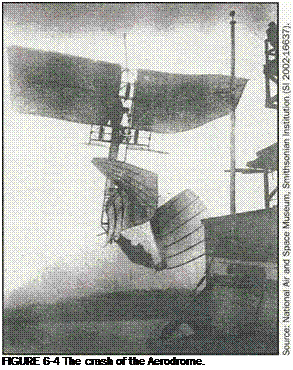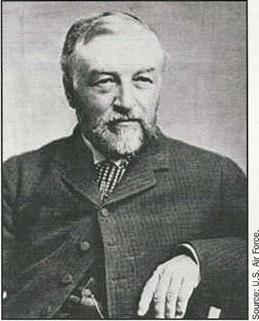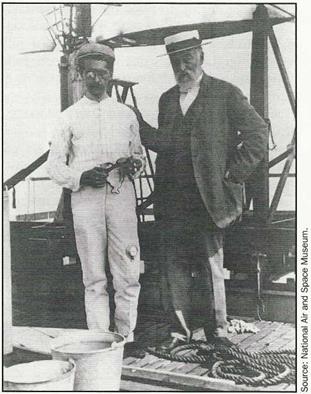Prelude to Powered Flight
■ n the fall of 1903, aerodynamic research і had proved the practicality of gliding flight, capable of carrying a man on wings of various designs. Rudimentary control had been shown in gliding flight, but with inconsistent results, and lack of control had caused the recent deaths of at least two gliding aeronauts. Sustained powered flight had been shown using models with steam engines. Reaching the goal of sustained, manned, and controlled flight was tantalizingly close, and was seemingly within the grasp of several different experimenters, yet it remained completely out of reach—as far away as the moon. The combined knowledge and experience of all of the preceding pioneers of flight hung in suspension just above their heads, awaiting some catalyst— some insight or development—that would crystallize all of it into successful, sustained flight. Of all such contenders, the most promising in the fall of 1903 seemed to be Samuel P. Langley (see Figure 6-1), an astronomer, mathematician, physicist, and third Secretary of the Smithsonian Institution in Washington, D. C.
Langley’s formal education ended on his graduation from the Boston Latin School, but he was self-taught in mathematics, physics, and astronomy. When he was nine years old, he was heavily into reading books on astronomy, and
|
FIGURE 6-1 Samuel Langley. |
he built telescopes of various types, using them to observe the moon and the planets. He secured placement as an assistant astronomer at Harvard College Observatory during the middle 1860s, and then took a position at the U. S. Naval Academy as a professor of mathematics. His work in
Annapolis mostly related to the restoration of the observatory at the Academy.
After a year, Langley went to the Allegheny Observatory of the Western University of Pennsylvania (now the University of Pittsburgh), where he began to engage in pioneering work in solar observation and discovery, and where he developed astronomical instruments and conducted research that brought him a degree of recognition and fame. His work naturally led to publications in scientific journals and periodicals, and in turn he met and became familiar with inventors and scientists in many cognate fields of exploration, including the pursuit of heavier than air flight.
From his university life he moved to Washington, D. C., in order to take the appointment to the Smithsonian Institution as its third Secretary in 1887. The Smithsonian Institution was founded in 1846 by Congressional act to establish a charitable trust to create a museum, a library, and a program of research, publication, and collection in the sciences, arts, and history. The Secretary of the Smithsonian is the chief executive officer of the Institution.
After arriving in Washington, D. C. in 1887, Langley continued the research that he had earlier begun in studying aerodynamic lift. He constructed a whirling table (in order to generate wind) on which he affixed various bird wings, by which means he was able to observe the lifting characteristics of the particular designs. Langley worked briefly with gliders, consulting the work of Sir George Cayley of some 75 years earlier, who had also studied bird wings in shaping wings he constructed. The Smithsonian was a refuge and bulwark of naturalists, and it was easy for Langley to conduct research in that environment. He mused at the time, “I watched a hawk soaring far up in the blue, and sailing for a long time without any motion of its wings . . . How wonderfully easy, too, was its flight! I was brought to think of these things again, and to ask myself whether the problem of artificial flight was really as hopeless and as absurd as it was then thought to be.”
This was also the time of other true believers, like Lilienthal and Chanute, whose work concentrated on lift experiments with gliders. But Langley moved away from gliders, favoring the development of a complete, self-sustaining aerial machine that would, by its own power, show that manned flight was ultimately possible.
He did this by building a series of models, which he called “Aerodromes” sequentially numbered, the first of which was completed in 1892, but not flown. By 1894, he had settled on a design that used two sets of equal-sized wings in tandem (one set of wings located behind a first set forward), on which he placed small contrivances of motive power, using compressed gas or steam. He converted a 38-foot houseboat, with a workshop, into a launch platform and towed it down the Potomac River to a point near Quan – tico, Virginia.
From here he tested Aerodrome 4 (all attempts were failures, resulting in each of the models falling into the water), and Aerodrome 5, which sustained a flight in October, 1894, for 35 feet and three seconds. A year and a half later, on May 6, 1896, Aerodrome No. 6 was launched from the houseboat’s catapult but its left wing collapsed and the model landed in the water. At 3:05 p. m. that same day, Aerodrome No. 5, 13 feet long and weighing about 24 pounds, is launched and flies for a minute and a half, covering about one-half mile and reaching 100 feet altitude. This is the first successful sustained flight of a heavier-than-air machine ever recorded. At 5:10 p. m., Langley does it again as the machine climbs to 60 feet and flies in circles for 1 minute and 31 seconds. Dr. Alexander Graham Bell, the only witness to the flight who was not a staff member, photographed the accomplishment. Joy abounded.
The see-saw battle against gravity proceeded in fits and starts. In June, Chanute conducts his acclaimed glider experiments at the Lake
Michigan dunes using his box glider design, which will be later borrowed by the Wright brothers to good effect. In August, after over
2,0 gliding flights, the intrepid Lilienthal dies when his glider stalls and crashes from an altitude of about 50 feet. On November 28, Langley repeats his success as Aerodrome No. 6 flies 4,800 feet in 1 minute and 45 seconds.
On February 15, 1898, the USS Maine sank in Havana harbor, with the death of 266 sailors, due to a massive explosion. The Maine was in Cuba to protect American citizens during revolutionary unrest caused by Cuban freedom-fighters against Spanish colonial rule. A Navy Board of Inquiry concluded that the Maine had been sunk by a mine placed on her hull. Although the government did not affix blame for the mine’s placement, an outraged public blamed Spain. This was one of the precipitating factors to the American entry into war with Spain (the Spanish – American War), which began on April 21, 1898.
Between the sinking of the Maine and the declaration of war, on March 25, 1898, the Assistant Secretary of the Navy, Theodore Roosevelt, suggested the development of Langley’s Aerodrome as a possible weapon of war to Navy Secretary John D. Long. This shortly resulted in a grant from the War Department of $50,000 to Langley for the construction of a full-sized version of the Aerodrome model capable of carrying a man in controlled flight.
The Smithsonian is intricately connected to the federal government, and has always been largely funded by federal dollars and administered by officials from the three branches of the federal government. It was natural, then, that the federal government would fund advanced research that had already been started under the auspices of the Smithsonian Institution. It is not clear that this was a welcome development to Langley, as many have supposed that he intended to complete his aeronautical experiments and contributions with the successful flights of the models he had already produced.
Still, Langley accepted the assignment and was immediately confronted with several significant challenges. First, his plan was simply to scale up the models that he had successfully flown into a full-sized flying machine capable of carrying a person. Based on later analysis by the Smithsonian National Air and Space Museum,1 this was an error of failure-producing proportion since the aerodynamics, structural design, and control system of the smaller craft were not adaptable to the full-sized version. However, Langley’s primary focus was not on the integrity of the craft’s structure, but on its propulsion.
In 1898 there existed no available engine that could produce sufficient horsepower for mounting on a full-sized flying machine, primarily due to considerations of weight. The best ones available produced only about one horsepower for each 20 pounds of engine weight. In spite of his accomplishments, Langley was not an engineer, nor was he an expert in either propulsion or structure. He had concluded, however, that steam engines were not suitable for large flying machines. This left as the only alternative the gasoline internal combustion engine, which had been invented by Gottlieb Daimler in 1885. Meaningful advances in the internal combustion engine were, at that time, awaiting the arrival of the automobile industry. Langley also concluded that he could use some engineering assistance.
Charles Manly, who was set to graduate from Cornell University as a mechanical engineer in 1898, was recommended to Langley by a professor friend of his at that school. Langley hired Manly in June 1898, and by October the two of them had begun major work on the Great Aerodrome, as it was called (see Figure 6-2). Manly had calculated that the machine would require at least two 12 horsepower motors, each weighing no more than 100 pounds. Finding none available, Langley contracted with automobile engine manufacturer Stephen Marius Balzer of New York to build it. After two years of effort, Balzer’s engine, which was a 5-cylinder radial type, was not functional
|
FIGURE 6-2 Samuel Langley and Charles Manly. Note magnetic compass attached to the left leg of Charles Manly. |
and Balzer was near bankruptcy. Manly prevailed upon Langley to assign the project of building the engine to him, and by September of 1900, Manly had produced an experimental engine weighing 108 pounds and producing І8У2 horsepower. Manly had, in effect, produced a motor that would perform to almost twice the specifications of the original. As he later said, “At the time very little was known about the ‘proper way of constructing’ an engine and what work had been done was jealously guarded against patent theft by the automobile industry.”
By January 1902, the 5-cylinder radial engine had been successfully developed and tested, and it produced 51 horsepower while weighing only 207 pounds, including water for cooling (see Figure 6-3). His weight to power ratio was an unbelievable 4 to 1. The unsuccessful Balzer engine’s design specification had been 8 to 1.
The remaining news about the finished aircraft known as the Aerodrome A, on the other hand, was not so good. The fuselage was constructed of steel tubing. The wings and tail were of wood covered by Percaline (lightweight cotton). The frame of the craft, and both the design and construction of the tandem wing setup, was produced without the benefit of manned glider testing. Given its large size (it was 52 feet long with a wing span of 48 feet), it was flimsy. It did not help that the structure had to sit 11 feet above the ground to provide propeller clearance. Strangely, the Aerodrome had no landing gear or flotation devices. There were no specific provisions for lateral control except for a rudder mounted aft and beneath the fuselage of the craft. The press assigned it the moniker “the Dragonfly.”
Refinements and finishing touches were made during 1903, and on October 7, things were all in order for the launch. Although Langley had planned to use ballast or dummy passengers, Manly insisted that he be permitted to pilot the craft. The launching mechanism had been enlarged, inspected, and tested. The Aerodrome had been affixed atop the launching mechanism and stood ready. The engine was cranked and was running smoothly. Wearing a cork-lined coat for flotation, and with a compass affixed to his left trouser leg to assist in navigating a lengthy flight, Manly mounted the Aerodrome atop the houseboat and signaled that he was ready. Two sky rockets were launched and the tugs holding the houseboat into the wind tooted to signal the launch.
With the press in full attendance, what happened next is described by Dr. A. G. Bell in a speech ten years later:
. . . but when the catapult was released the aerodrome sped along the track on the top of the houseboat attaining sufficient headway for normal flight; but at the end of the rails it was jerked violently down at the front, and plunged headlong into the river.
 |
Langley was lampooned in the press, his aircraft maligned as a “buzzard,” and his launch platform and houseboat ridiculed as the “Ark.” The Washington Post said the Aerodrome plunged into the Potomac “like a handful of mortar.” Despite the very public failure, the commitment to flight remained steadfast. Manly was chagrined but unhurt, the engine was undamaged, and the Aerodrome was repairable. On December 8, 1903, with the Wright brothers hard at work on their craft at Kitty Hawk, all was again in readiness for history to be made. According to Dr. Bell:
This time the rear guy post was injured, crippling the rear wings, so that the aerodrome pitched up in front and plunged over backwards into the water. . .
The Washington Star headlined on December 9, 1903, “AIRSHIP FAILS TO FLY,” accompanied by a distressing photograph of the Aerodrome
just after launch, captioned “Collapse of the Airship.” (See Figure 6-4.) Within three years Langley was dead, the object of ridicule. In 1913 Dr. Bell believed that the catapult was the only problem:
It will thus be seen that Langley’s aerodrome was never successfully launched, so that it had no opportunity of showing what it could do in the air. The defect lay in the launching mechanism employed and not in the machine itself, which is recognized by all experts as a perfectly good flying machine, excellently constructed and made long before the appearance of other machines.
The remains of Aerodrome A were carefully packed up in crates and stored at the Smithsonian Institution. But the end of the story of the Aerodrome was not yet at hand. In fact, the Aerodrome failure just two weeks before the Wright brothers’ first successful manned flight in Kitty Hawk,
 N. C. was to fuel a controversy that would fester for decades to come. It would cause the Smithsonian Institution to question the Wright brothers’ claims to be the true “inventors” of the airplane, which, in turn, would cause the original Wright Flyer to be sent to the London Science Museum for exhibition rather than to the Washington Smithsonian. It would play a part in the rupture of the close and fraternal early aeronautical community and become a foil in the patent wars to come between the Wright brothers and the rest of the world over the issue of who owned the right to fly. The failure of the Aerodrome was to be just one poignant vignette among many as man strived to produce the world’s first practical airplane in the early years of the 20th century. [3] [4]
N. C. was to fuel a controversy that would fester for decades to come. It would cause the Smithsonian Institution to question the Wright brothers’ claims to be the true “inventors” of the airplane, which, in turn, would cause the original Wright Flyer to be sent to the London Science Museum for exhibition rather than to the Washington Smithsonian. It would play a part in the rupture of the close and fraternal early aeronautical community and become a foil in the patent wars to come between the Wright brothers and the rest of the world over the issue of who owned the right to fly. The failure of the Aerodrome was to be just one poignant vignette among many as man strived to produce the world’s first practical airplane in the early years of the 20th century. [3] [4]












